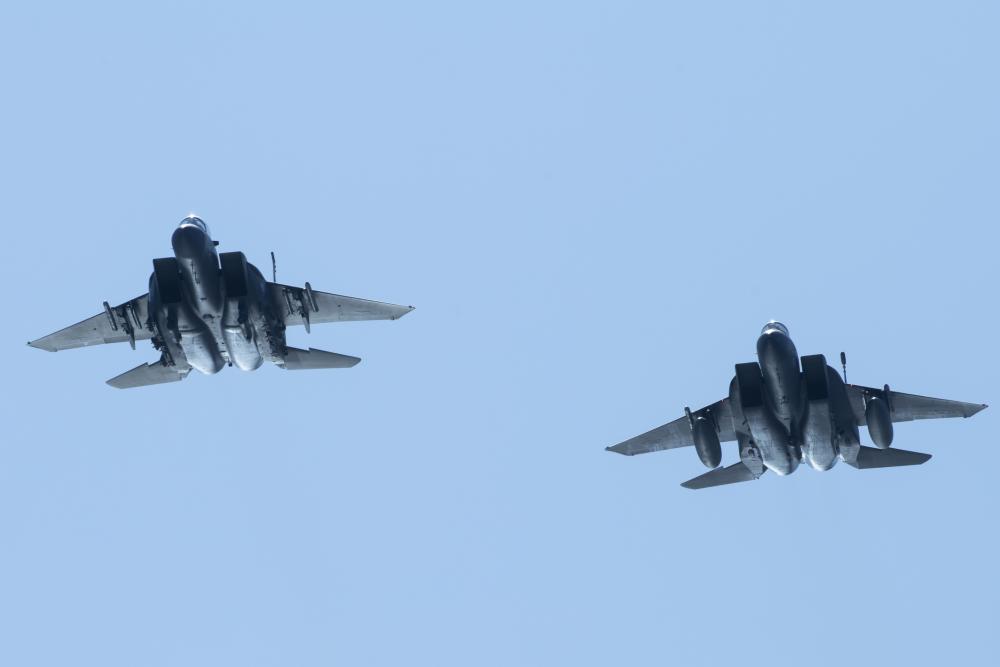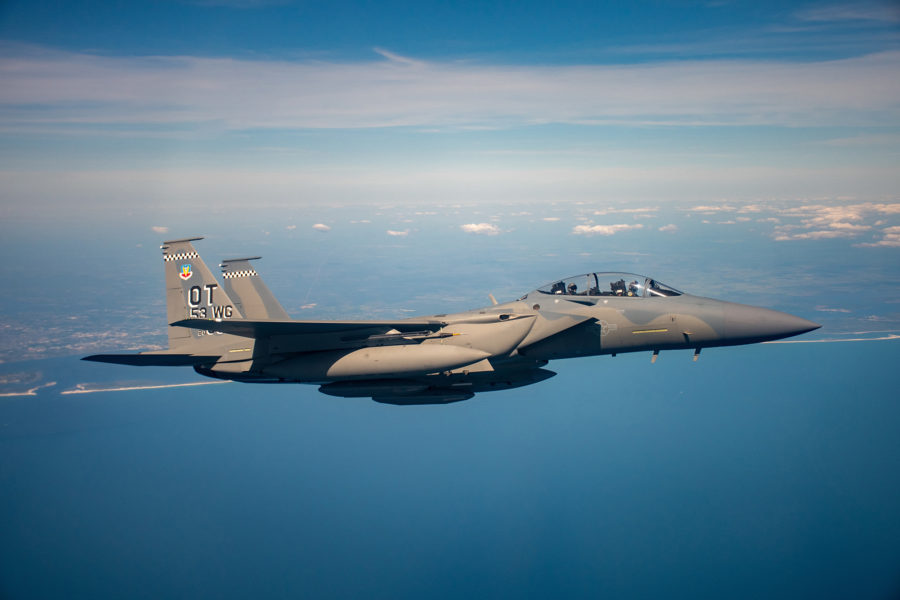Editor’s Note: The original version of this story reported the cost of EPAWSS is separate from the cost of the F-15EX, but it is not. EPAWSS unit costs are applicable only to older-model F-15Es receiving the suite as an upgrade. The F-15EX unit cost of $93.95 million includes EPAWSS.
The F-15EX Eagle II unit cost will be $93.95 million per plane in then-year dollars, assuming the Air Force sticks with its plan to buy 104 of the fighters and Congress concurs, the service said in its most recent annual Selected Acquisition Report.
It is the first SAR for the F-15EX, after it shifted from being a Middle-Tier Acquisition effort to a Major Defense Acquisition Program.
In a separate report, the Air Force reported a jump in unit costs for the F-15 Eagle Passive/Active Warning Survivability System, because the service sharply reduced the number of the electronic warfare suites it will buy to equip the F-15E Strike Eagle fleet.
The F-15EX program actually saw a unit cost decline of 5.24 percent from the 2020 baseline program, the result of the Air Force reversing course on some of the planned cuts to the fleet. Further tinkering with the final number of aircraft procured would likely affect the Acquisition Procurement Units Cost (APUC) of $93.95 million. The previous APUC, with the smaller buy, was $114.2 million.
The F-15EX report is based largely on calendar 2022 information, but it has been updated with data reflecting the fiscal year 2024 Air Force plan to increase the overall buy by 24 aircraft in fiscal 2025.
Boeing builds the F-15EX, which is based on the F-15QA built for Qatar. Changes from the F-15E include a very powerful processor, two additional weapon stations, and a fly-by-wire system. At the outset of the program, Boeing estimated a unit cost of about $80 million for the F-15EX.
The unit cost is significant in the ongoing debate over where to invest the Air Force’s limited dollars for air superiority. Other priorities include the F-35A, which in its last contract cost about $80 million per fighter; the still-in-development Next Generation Air Dominance fighter; the autonomous Collaborative Combat Aircraft program in development; and upgrades for the existing fourth- and fifth-generation fighter fleet.
After initially resisting the F-15EX when Pentagon leadership inserted it in the Air Force budget in 2018, the service has embraced the updated Eagle as a way to arrest the aging of the fighter fleet, with an average age approaching 30 years.
Given limits on F-35 production capacity, the immaturity of NGAD and CCA, and the urgent need to replace much of the structurally-fatigued F-15C/D fleet, the Air Force believes the F-15EX to be an expedient stopgap. The service sees the fighter as a “multirole” platform: a standoff shooter against high-end threats, a weapons truck, and in ground-attack roles after enemy defenses have been beaten down.
“Many F-15C/Ds are beyond their service life and have SERIOUS structure risks, wire chafing issues, and obsolete parts,” the service said in the acquisition report.
“Readiness goals are unachievable due to continuous structural inspections, time-consuming repairs, and on-going modernization efforts,” the Air Force noted. “The average F-15C/D is 38 years old and 75 percent of the fleet have exceeded their 9,000-hour certified service life. The oldest F-15C was delivered in 1979. F-15EX logistics, maintenance, and training will heavily leverage existing F-15 infrastructure.”

With F-15EX initially being a Middle Tier of Acquisition program, the Air Force was able to get the first two aircraft less than a year after a contract award. Now as a major acquisition program, it will “maintain the momentum to acquire F-15EX aircraft to quickly recapitalize the F-15C/D inventory,” the report stated, though the quantities quoted depend on Congress approving the Air Force’s request for a $145 million Above Threshold Reprogramming (ATR) request “to enable the procurement of two Lot 3 aircraft that cannot currently be funded due to a $77M FY 2021 rescission and $82M FY 2022 Congressional mark,” the service said.
The F-15EX’s survivability in a future fight will depend on the Eagle Passive/Active Warning Survivability System (EPAWSS), an electronic warfare and jamming suite which warranted its own report. The unit cost of EPAWSS has spiked due to the Air Force’s decision to equip a much smaller number of F-15E Strike Eagles with the system: 99, down from 217. The cost spike has resulted in a Nunn-McCurdy breach, which means the Secretary of Defense must certify the program as essential or it will be automatically canceled.
The program unit acquisition cost for the EPAWSS is $17.355 million per system in then-year dollars, the Air Force said, while the average procurement unit cost is $13.3 million. The previous baseline unit costs were $13.3 million and $10.1 million, respectively.
Boeing’s Donn Yates, executive director for Boeing fighters and trainers business development, said in a Sept. 11 briefing for reporters at AFA’s Air, Space & Cyber Conference that F-15EX Nos. 3-8 were to be delivered between the end of the fourth quarter of fiscal 2023 and the first quarter of fiscal 2024. Nos. 3, 4, 5, and 6 will go to Eglin Air Force Base, Fla., to participate in testing, Yates said, while Nos. 7 and 8 will be the first “operationally configured” EXs, which will be assigned to the Oregon Air National Guard.
Negotiations on Lots 2, 3, and 4 were underway at the time of the briefing, Yates said, predicting “that will wrap up … relatively soon.” Boeing is eyeing production rates of up to 48 aircraft per year, and noted that Indonesia has signaled an intent to buy 24 of the jets, with other potential customers showing interest too.
The acquisition report stated that the F-15EX’s Initial Operational Capability is projected for June or July 2024, but that the program is running ahead of schedule in this respect. A full-rate production decision could be forthcoming as soon as next month, but the official schedule calls for June 2024, the Air Force reported.
Full operational capability (FOC) for F-15EX is planned in 2027, but this may also happen sooner than expected, the Air Force said. The report defined FOC as 44 aircraft with all necessary unique maintenance and test gear, spares, and maintainers and pilots trained.
The report added that the then-year, or actual cost of the F-15EX program, including development, program acquisition, and military construction, will be $12.47 billion.
